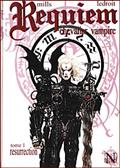EPICA (nl) - Consign to Oblivion (2005)

Label : Transmission Records / Season of Mist
Sortie du Scud : 2005
Pays : Pays Bas
Genre : Metal Gothique Symphonique
Type : Album
Playtime : 11 Titres - Mins
Avec à peine 2 ans d'existence, le groupe de Metal gothique Epica nous sort déjà un nouvel album, très bien ficelé, qui garde les bons éléments du premier album, mais en allant encore plus loin pour un meilleur résultat. Mark Jansen s'inspire beaucoup de voyages et des cultures pour ses compositions, et cette fois, c'est la culture Maya qui a inspiré la plus grande partie des morceaux de l'album, comme en témoigne la pochette.
Les grunts de Mark sont toujours présents, et ils se mélangent à la perfection avec la sublime voix de Simona. Cette dernière, qui n'avait que 17 ans lors du premier album, a beaucoup évolué dans son chant lyrique, qui comprend plus de variations, plus de subtilités, plus de tonalités différentes. Sur un morceau comme "Trois Vierges", une balade très épurée au niveau musique et qu'elle chante merveilleusement bien, on se rend pleinement compte de ses capacités vocales. On notera sur cette chanson la participation de Roy Kahn de Kamelot. Dommage cependant que ce titre manque un peu de relief. Les chœurs sont omniprésents tout au long de l'album, renforçant le côté épique, tandis que les influences de musiques de films se font sentir dès l'introduction, qui pourrait être tout droit sortie d'un film hollywoodien de fantasy.
Sur cet album, on retiendra en particulier "The Last Crusade", titre qui aurait tout à fait mérité d'être le premier single. Un morceau très efficace, très rythmé, avec des riffs puissants, une batterie qui martèle, et surtout, un refrain vraiment excellent et qui reste très longtemps en tête! Si vous avez entendu ce morceau en live, vous le reconnaîtrez, c'est sûr!
C'est sur "Force of the Shore" que les grunts de Mark apparaissent pour la première fois. Ils sont alternés avec un chant envoûtant de Simona, et le contraste qui résulte entre chant "enragé" et chant lyrique est tout simplement génial. Sur "Mother of Light", un autre morceau à retenir, les grunts de Mark reviennent, mais cette fois on les entend en même temps que la voix de Simona: un effet différent, mais tout aussi excellent!
"Consign to Oblivion" est le titre préféré de Mark, et l'on comprend pourquoi: il s'en donne à coeur joie dans les grunts ! Malgré la longueur (9'45) de ce morceau, il n'y a pas une seconde de trop! Les 2 ou 3 titres de l'album manquant un peu de relief sont vite oubliés avec des morceaux comme celui-là, qui résume parfaitement tous les points forts de l'album: des chœurs omniprésents, la voix envoûtante de Simona mélangée aux grunts de Mark (très variés sur ce titre), des riffs puissants, des refrains efficaces, et des passages orchestraux magnifiques.
Après le premier album "The Phantom Agony", "Consign to Oblivion" est une relève solide qui ravira tous les fans du genre. Il s’agit d’un album efficace et exalté, très plaisant à écouter.
Ajouté : Vendredi 13 Mai 2005
Chroniqueur : Eowyn
Score :    
Lien en relation: Epica Website
Hits: 15823
|














